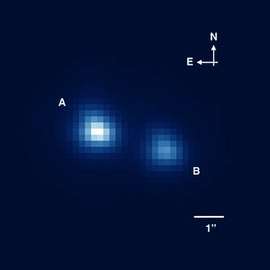EBLM J0555-57
EBLM J0555-57 is a triple star system approximately 600 light-years from Earth. EBLM J0555-57Ab, the smallest star in the system, orbits its primary star with a period of 7.8 days, and at the time of discovery, was the smallest known star with a mass sufficient to enable the fusion of hydrogen in its core.
 Resolved image of EBLM J0555-57A (left) and EBLM J0555-57B (right) taken with the Leonhard Euler Telescope at the ESO's La Silla Observatory[1] Credit: ESO | |
| Observation data Epoch J2000 Equinox J2000 | |
|---|---|
| Constellation | Pictor |
| Right ascension | 05h 55m 32.6868s[2] |
| Declination | −57° 17′ 26.064″[2] |
| Apparent magnitude (V) | 9.98 / 10.76[1] |
| Characteristics | |
| Spectral type | F8[3] |
| Variable type | Eclipsing[1] |
| Astrometry | |
| Radial velocity (Rv) | 23.419 ± 0.74[4] km/s |
| Proper motion (μ) | RA: 3.858[2] mas/yr Dec.: -39.713[2] mas/yr |
| Parallax (π) | 5.16 ± 0.36[2] mas |
| Distance | 630 ± 40 ly (190 ± 10 pc) |
| Position (relative to A) | |
| Component | B |
| Epoch of observation | 1998 |
| Angular distance | 2.50″ [3] |
| Position angle | 254° [3] |
| Observed separation (projected) | 479 AU [1] |
| Orbit[1] | |
| Primary | Aa |
| Companion | Ab |
| Period (P) | 7.757676+0.000029 −0.000025 d |
| Semi-major axis (a) | 0.0817 ± 0.0019 au |
| Eccentricity (e) | 0.0894+0.0035 −0.0036 |
| Inclination (i) | 89.84+0.2 −1.8° |
| Argument of periastron (ω) (secondary) | −53.7+1.5 −1.8° |
| Details[1] | |
| EBLM J0555-57Aa | |
| Mass | 1.13 ± 0.08 M☉ |
| Radius | 0.99+0.15 −0.03 R☉ |
| Surface gravity (log g) | 4.18 ± 0.21 cgs |
| Temperature | 6461 ± 124 K |
| Metallicity [Fe/H] | −0.24 ± 0.16 dex |
| Rotational velocity (v sin i) | 7.60 ± 0.28 km/s |
| EBLM J0555-57Ab | |
| Mass | 85.2+4.0 −3.9 MJup |
| Radius | 0.84+0.14 −0.04 RJup |
| Surface gravity (log g) | 5.50+0.03 −0.13 cgs |
| EBLM J0555-57B | |
| Radius | 0.94 ± 0.08 R☉ |
| Temperature | 5717 ± 124 K |
| Other designations | |
| Database references | |
| SIMBAD | data |
System
EBLM J0555-57, also known as CD−57 1311, is a triple star system[1][5] in the constellation Pictor, which contains a visual binary system consisting of two sun-like stars separated by 2.5": EBLM J0555-57Aa, a magnitude 9.98 spectral type F8 star, and EBLM J0555-57B, a magnitude 10.76 star. No orbital motion has been detected but they have almost identical radial velocities and are assumed to be gravitationally bound.[1]
Component A of the system is itself an eclipsing binary (EBLM J0555-57Ab orbiting EBLM J0555-57Aa). Eclipses, also known as transits in the context of planetary searches, have been detected in the near infrared, with brightness drops of 0.05% during the eclipse. The shape and duration of the transits allow the radii of the two stars to be determined. A full solution of the orbit gives a period of 7 days and 18 hours, with a low eccentricity of 0.09, an almost edge-on inclination of 89.84°, and a semi-major axis of 0.08 AU.[1]
EBLM J0555-57Ab
EBLM J0555-57Ab has a mass of about 85 ± 4 Jupiter masses, or 0.081 Solar masses. The star has a radius comparable to that of Saturn.[1] EBLM J0555-57Ab is situated at the lower mass limit for hydrogen-burning stars predicted by current stellar models. EBLM J0555-57Ab was discovered by a group of scientists at the University of Cambridge associated with the EBLM project (Eclipsing Binary, Low Mass),[1] using data collected by the WASP project. WASP (Wide Angle Search for Planets) is searching for exoplanets using the transit method.[6] Additional properties of the star were determined using Doppler spectroscopy, to measure the periodic radial velocity variation of the primary star due to the gravitational influence of its companion.[1]
| Wikinews has related news: |
References
- von Boetticher, Alexander; Triaud, Amaury H. M. J.; Queloz, Didier; Gill, Sam; Lendl, Monika; Delrez, Laetitia; Anderson, David R.; Collier Cameron, Andrew; Faedi, Francesca; et al. (2017). "The EBLM project III. A Saturn-size low-mass star at the hydrogen-burning limit". 1706. arXiv:1706.08781. Bibcode:2017A&A...604L...6V. doi:10.1051/0004-6361/201731107. Cite journal requires
|journal=(help) - Gaia Collaboration (2016). "Gaia Data Release 1". Astronomy & Astrophysics. 595: A2. arXiv:1609.04172. Bibcode:2016A&A...595A...2G. doi:10.1051/0004-6361/201629512.
- Mason, Brian D.; Wycoff, Gary L.; Hartkopf, William I.; Douglass, Geoffrey G.; Worley, Charles E. (2001). "The 2001 US Naval Observatory Double Star CD-ROM. I. The Washington Double Star Catalog". The Astronomical Journal. 122 (6): 3466. Bibcode:2001AJ....122.3466M. doi:10.1086/323920.
- Kunder, Andrea; Kordopatis, Georges; Steinmetz, Matthias; Zwitter, Tomaž; McMillan, Paul J.; Casagrande, Luca; Enke, Harry; Wojno, Jennifer; Valentini, Marica; Chiappini, Cristina; Matijevič, Gal; Siviero, Alessandro; De Laverny, Patrick; Recio-Blanco, Alejandra; Bijaoui, Albert; Wyse, Rosemary F. G.; Binney, James; Grebel, E. K.; Helmi, Amina; Jofre, Paula; Antoja, Teresa; Gilmore, Gerard; Siebert, Arnaud; Famaey, Benoit; Bienaymé, Olivier; Gibson, Brad K.; Freeman, Kenneth C.; Navarro, Julio F.; Munari, Ulisse; et al. (2017). "The Radial Velocity Experiment (RAVE): Fifth Data Release". The Astronomical Journal. 153 (2): 75. arXiv:1609.03210. Bibcode:2017AJ....153...75K. doi:10.3847/1538-3881/153/2/75.
- Wenz, John (11 July 2017). "This Is the Smallest Star Ever Discovered". Popular Mechanics. Retrieved 17 July 2017.
- "Smallest-ever star discovered by astronomers". Phys.org. 12 July 2017. Retrieved 12 July 2017.
External links
- Smallest ever star discovered by astronomers University of Cambridge